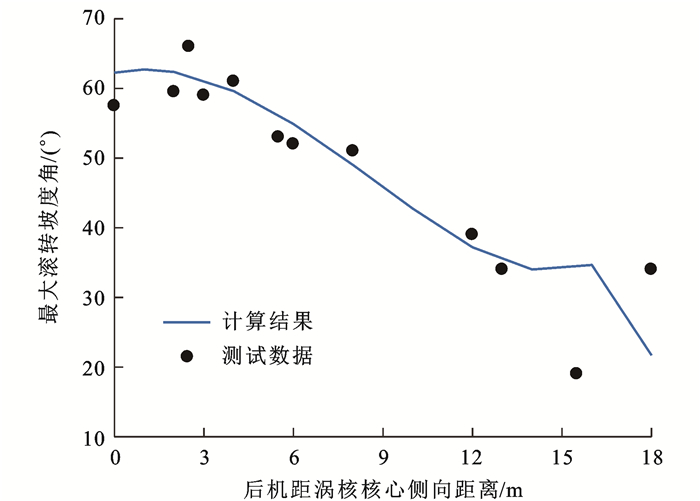Multi-parametric evaluation method of aircraft wake vortex encounter safety in cruise phase
-
摘要: 分析了飞机遭遇尾涡后的响应机理,综合考虑飞机滚转阻尼特性及操纵品质等因素,建立了飞机滚转角加速度计算模型;因飞机遭遇尾涡后飞行轨迹及飞行姿态发生改变,选择了多个扰动参数评估尾涡遭遇安全性,建立了飞机动力学参数计算模型;为确定尾涡遭遇可接受安全水平,基于国内现行尾流间隔标准,统计了中低空典型机型组合的尾流遭遇受扰参数计算数据;分析了高空尾涡流场演化特性,计算了高空巡航状态下的尾流安全间隔,分析了不同因素对飞行安全的影响。研究结果表明:与中低空相比,高空尾涡流场的初始强度大,持续距离长,飞行高度超过9 000 m后,尾涡消散随高度的增大而加快;当前机为超级重型机、重型机,现行尾流间隔无法保证飞行安全,需增加安全间隔1.4~2.1 km,飞行高度分别超过13 800、14 400 m后,尾涡遭遇严重度降低;当前机为一般重型机时,尾流安全间隔可缩减1.5 km以提高空域利用效率;当前机为中型机时,尾涡遭遇安全性较高,但此时受最小雷达间隔限制,无法进一步缩减前后机间距;后机的飞行速度越低,发生尾涡遭遇的严重程度越高;在后机初始滚转坡度角由0增加到10°的过程中,尾涡安全间隔增加1.3 km,增加幅度约为8.61%。可见,采用多个受扰参数能有效评估高空尾涡遭遇严重程度。Abstract: The response mechanism of aircraft after encountering wake vortices was analyzed. Considering the factors such as roll damping characteristics and handling qualities of aircraft, the calculation model for the roll angular acceleration of aircraft was constructed. Due to the change in the flight path and attitude after wake vortex encounters, several disturbance parameters were selected to evaluate the safety of wake vortex encounters, and the calculation model for aircraft dynamics parameters was built. For the determination of the acceptable safety level of wake vortex encounters, the computation data of the disturbance parameters for wake vortex encounters of aircraft combinations at medium and low altitudes were obtained on the basis of the current domestic standard of wake separation. The evolutionary characteristics of the flow fields of wake vortices at high altitudes were analyzed, the wake safety separation at high altitudes was studied, and the influence of different factors on flight safety was analyzed. Research results show that compared with the results at medium and low altitudes, the flow fields of wake vortices at high altitudes are characterized by larger initial strength and duration. Beyond the flight altitude of 9 000 m, the speed of wake vortex dissipation increases with the rise in height. When the leading aircraft is a super heavy aircraft or heavy aircraft, flight safety cannot be guaranteed by current wake separation, and the safety separation should increase by 1.4-2.1 km. When the flight altitude is beyond 13 800 and 14 400 m, the severity of wake vortex encounters reduces. When the leading aircraft is a general heavy aircraft, the wake safety separation can reduces by 1.5 km to improve airspace utilization efficiency. In the case of a medium-size leading aircraft, the safety of wake vortex encounters is high, but due to the limitation of the minimum radar separation, the distance between the leading and following aircraft cannot further reduce. A lower flight speed of the following aircraft is accompanied by more serious wake vortex encounters. When the initial roll bank angle of the following aircraft raises from 0 to 10°, the safety separation of wake vortices raises by 1.3 km, an increase of about 8.61%. It can be seen that the use of multiple disturbance parameters is effective in evaluating the severity of high-altitude wake vortex encounters. 4 tabs, 15 figs, 30 refs.
-
表 1 RECAT-CN尾流间隔试验运行标准
Table 1. RECAT-CN wake separation test operation standard
km 航空器机型 后机 J B C M L 前机 J 5.6 9.3 11.1 13.0 14.8 B 5.0 5.6 7.4 9.3 13.0 C 5.0 5.0 5.6 6.5 11.1 M 5.0 5.0 5.0 5.0 9.3 L 5.0 5.0 5.0 5.0 5.6 表 2 43种常见典型机型相关参数
Table 2. Related parameters of 43 typical different aircraft types
机型 A380 B744 A346 B773 MD11 B772 A343 … F50 最大着陆质量/t 386.00 281.23 256.04 237.68 222.94 201.85 186.03 … 19.73 最大起飞质量/t 560.01 385.55 365.06 299.37 285.99 247.21 257.04 20.82 机翼面积/m2 844.99 541.16 436.99 427.81 338.91 427.81 361.59 70.00 翼展/m 79.77 64.92 63.42 60.92 51.66 60.92 60.31 29.01 梢根比 0.224 8 0.277 5 0.200 0 0.148 6 0.245 9 0.148 5 0.219 8 0.450 0 滚转阻尼力矩系数/rad-1 -0.477 1 -0.505 6 -0.467 7 -0.442 5 -0.491 9 -0.442 4 -0.477 4 -0.641 1 进近着陆速度/kt 133 145 141 141 151 130 132 101 巡航平均表速/kt 320 300 290 300 300 300 290 210 巡航平均马赫数 0.85 0.85 0.82 0.84 0.83 0.84 0.82 0.68 RECAT-CN类别 J B B B C B B M 表 3 高空尾涡遭遇安全性标准
Table 3. High-altitude wake vortex encounters safety standards
最大滚转坡度角/(°) 最大真空速增加量/(m·s-1) 最大下降率/(m·s-1) 最大下降高度/m 最大载荷因子 19.3 6.61 -10.28 -49.67 1.29 表 4 不同类别机型组合高空尾流安全间隔对比
Table 4. Comparison of wake safety separations for combinations of different aircraft types at high altitude
前机机型 A380 B744 B764 现行尾流间隔标准/km 13.0 9.3 6.5 高空尾流安全间隔/km 15.1 10.7 5.0 尾流安全间隔变化/km 2.1 1.4 -1.5 -
[1] 徐肖豪, 赵鸿盛, 王振宇. 尾流间隔缩减技术综述[J]. 航空学报, 2010, 31(4): 655-662. https://www.cnki.com.cn/Article/CJFDTOTAL-HKXB201004002.htmXU Xiao-hao, ZHAO Hong-sheng, WANG Zhen-yu. Overview of wake vortex separation reduction systems[J]. Acta Aeronautica et Astronautica Sinica, 2010, 31(4): 655-662. (in Chinese) https://www.cnki.com.cn/Article/CJFDTOTAL-HKXB201004002.htm [2] 魏志强, 徐肖豪. 飞机尾涡流场的建模与仿真计算研究[J]. 交通运输系统工程与信息, 2010, 10(4): 186-191. https://www.cnki.com.cn/Article/CJFDTOTAL-YSXT201004030.htmWEI Zhi-qiang, XU Xiao-hao. Modeling and simulating of flow field for aircraft wake vortex[J]. Journal of Transportation Systems Engineering and Information Technology, 2010, 10(4): 186-191. (in Chinese) https://www.cnki.com.cn/Article/CJFDTOTAL-YSXT201004030.htm [3] SCHUMANN U, SHARMAN R. Aircraft wake-vortex encounter analysis for upper levels[J]. Journal of Aircraft, 2015, 52(4): 1277-1285. doi: 10.2514/1.C032909 [4] HOLZÄPFEL F. Probabilistic two-phase wake vortex decay and transport model[J]. Journal of Aircraft, 2003, 40(2): 323-331. [5] STEPHAN A, SCHRALL J, HOLZÄPFEL F. Numerical optimization of plate-line design for enhanced wake-vortex decay[J]. Journal of Aircraft, 2017, 54(3): 995-1010. doi: 10.2514/1.C033973 [6] SARPKAYA T. Decay of wake vortices of large aircraft[J]. AIAA Journal, 1998, 36(9): 1671-1679. doi: 10.2514/2.570 [7] PROCTOR F H, HAMILTON D W, SWITZER G F. TASS driven algorithms for wake prediction[C]//AIAA. 44th AIAA Aerospace Sciences Meeting and Exhibit. Reston: AIAA, 2006: 1073. [8] CAMPOS L M B C, MARQUES J M G. On an analytical model of wake vortex separation of aircraft[J]. The Aeronautical Journal, 2016, 120(1232): 1534-1565. doi: 10.1017/aer.2016.89 [9] SPEIJKER L J P, VIDAL A, BARBARESCO F, et al. ATC-wake: integrated wake vortex safety and capacity system[J]. Journal of Air Traffic Control, 2007, 49(1): 17-32. [10] DE VISSCHER I, LONFILS T, WINCKELMANS G. Fast-time modeling of ground effects on wake vortex transport and decay[J]. Journal of Aircraft, 2013, 50(5): 1514-1525. doi: 10.2514/1.C032035 [11] LUCKNER R, HÖHNE G, FUHRMANN M. Hazard criteria for wake vortex encounters during approach[J]. Aerospace Science and Technology, 2004, 8(8): 673-687. doi: 10.1016/j.ast.2004.06.008 [12] 魏志强, 屈秋林, 刘薇, 等. 飞机尾涡流场参数的仿真计算方法研究综述[J]. 空气动力学学报, 2019, 37(1): 33-42. https://www.cnki.com.cn/Article/CJFDTOTAL-KQDX201901003.htmWEI Zhi-qiang, QU Qiu-lin, LIU Wei, et al. Review on the artificial calculating methods for aircraft wake vortex flow field parameters[J]. Acta Aerodynamica Sinica, 2019, 37(1): 33-42. (in Chinese) https://www.cnki.com.cn/Article/CJFDTOTAL-KQDX201901003.htm [13] 魏志强, 李志远, 刘薇. 侧风影响下的飞机尾流强度消散与涡核运动[J]. 空军工程大学学报(自然科学版), 2017, 18(6): 27-33. https://www.cnki.com.cn/Article/CJFDTOTAL-KJGC201706005.htmWEI Zhi-qiang, LI Zhi-yuan, LIU Wei. Research on aircraft wake vortex strength dissipation and vortex motion under crosswind impact[J]. Journal of Air Force Engineering University(Natural Science Edition), 2017, 18(6): 27-33. (in Chinese) https://www.cnki.com.cn/Article/CJFDTOTAL-KJGC201706005.htm [14] 朱睿, 刘锦生, 刘志荣, 等. 新概念机翼尾流特性实验[J]. 航空学报, 2017, 38(4): 120250. https://www.cnki.com.cn/Article/CJFDTOTAL-HKXB201704001.htmZHU Rui, LIU Jin-sheng, LIU Zhi-rong, et al. Experiment on a new concept wing layout with alleviated wake vortex[J]. Acta Aeronautica et Astronautica Sinica, 2017, 38(4): 120250. (in Chinese) https://www.cnki.com.cn/Article/CJFDTOTAL-HKXB201704001.htm [15] LIU Fei, LIU Xin-ze, MOU Ming-jiang, et al. Safety assessment of approximate segregated parallel operation on closely spaced parallel runways[J]. Chinese Journal of Aeronautics, 2019, 32(2): 463-476. [16] 韩红蓉, 李娜, 魏志强. 飞机遭遇尾涡的安全性分析[J]. 交通运输工程学报, 2012, 12(1): 45-49. https://www.cnki.com.cn/Article/CJFDTOTAL-JYGC201201012.htmHAN Hong-rong, LI Na, WEI Zhi-qiang. Safety analysis of aircraft encountering wake vortex[J]. Journal of Traffic and Transportation Engineering, 2012, 12(1): 45-49. (in Chinese) https://www.cnki.com.cn/Article/CJFDTOTAL-JYGC201201012.htm [17] 冯志勇. 尾流对飞行的影响及安全间隔研究[D]. 成都: 西南交通大学, 2007.FENG Zhi-yong. How wake vortexes affect the flights and safety separation research[D]. Chengdu: Southwest Jiaotong University, 2007. (in Chinese) [18] HALLOCK J N, HOLZÄPFEL F. A review of recent wake vortex research for increasing airport capacity[J]. Progress in Aerospace Sciences, 2018, 98: 27-36. [19] CHENG J, HOFF A, TITTSWORTH J, et al. The development of wake turbulence re-categorization in the United States[C]// AIAA. 8th AIAA Atmospheric and Space Environments Conference. Reston: AIAA, 2016: 3434. [20] ANTOLOVIC D, FRANJKOVIC D. Calculation of airplane wake turbulence re-categorisation effects[J]. Transportation Research Procedia, 2020, 51: 179-189. [21] 魏志强, 牟明江. 飞机尾流间隔标准中的机型分类方法[J]. 空军工程大学学报(自然科学版), 2019, 20(1): 32-37. https://www.cnki.com.cn/Article/CJFDTOTAL-KJGC201901006.htmWEI Zhi-qiang, MOU Ming-jiang. Study of classification of aircraft types in the wake turbulence separation standards[J]. Journal of Air Force Engineering University (Natural Science Edition), 2019, 20(1): 32-37. (in Chinese) https://www.cnki.com.cn/Article/CJFDTOTAL-KJGC201901006.htm [22] LUCKNER R, REINKE A. Pilot models for simulation of wake vortex encounters in cruise[C]//AIAA. AIAA Atmospheric and Space Environments Conference. Reston: AIAA, 2010: 7683. [23] ROJAS J I, MELGOSA M, PRATS X. Sensitivity analysis of maximum circulation of wake vortex encountered by en-route aircraft[J]. Aerospace, 2021, 8(7): 194-215. [24] HOLZÄPFEL F. Effects of environmental and aircraft parameters on wake vortex behavior[J]. Journal of Aircraft, 2014, 51(5): 1490-1500. [25] POIREL D, PRICE S J. Bifurcation characteristics of a two- dimensional structurally non-linear airfoil in turbulent flow[J]. Nonlinear Dynamics, 2007, 48(4): 423-435. [26] KAZARIN P, PROVALOV A, GOLUBEV V, et al. Terminal- zone wake vortex safety assessment in the context of UAS integration in the NAS[J]. Transportation Research Procedia, 2016, 14(1): 1364-1373. [27] 魏志强, 吴金栋, 刘馨泽, 等. 空中交通尾流间隔标准的安全性评估分析[J]. 中国安全生产科学技术, 2018, 14(12): 180-185. https://www.cnki.com.cn/Article/CJFDTOTAL-LDBK201812030.htmWEI Zhi-qiang, WU Jin-dong, LIU Xin-ze, et al. Safety assessment and analysis on standard of wake separation for air traffic[J]. Journal of Safety Science and Technology, 2018, 14(12): 180-185. (in Chinese) https://www.cnki.com.cn/Article/CJFDTOTAL-LDBK201812030.htm [28] HOOGSTRATEN M, VISSER H G, HART D, et al. Improved understanding of en route wake-vortex encounters[J]. Journal of Aircraft, 2015, 52(3): 981-989. [29] HOLZÄPFEL F. Probabilistic two-phase aircraft wake-vortex model: further development and assessment[J]. Journal of Aircraft, 2006, 43(3): 700-708. [30] CROW S C. Stability theory for a pair of trailing vortices[J]. AIAA Journal, 1970, 8(12): 2172-2179. -





 下载:
下载:
















